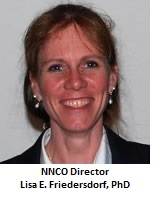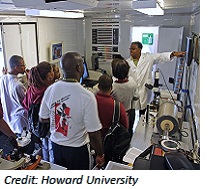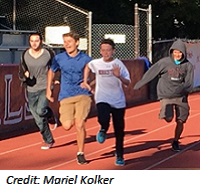NNCO Quarterly Newsletter: Spring 2021 Edition
|
|
| WHAT’S BIG IN SMALL SCIENCE? A Quarterly Newsletter of the National Nanotechnology Coordination Office (NNCO) |
|
DIRECTOR’S CORNER
Although it has only been a little over a year, I feel a bit like the cicadas emerging after 17 years into a strange world. With some trepidation, I am beginning to emerge, fully vaccinated, into the new not-quite-post-pandemic world. Although we have engaged via phone and video almost continuously on a daily basis, working in the office with NNCO Deputy Director Stacey Standridge this week has been amazing, and I look forward to opportunities for in-person engagement with you and the entire nanotechnology community as soon as reasonable. Although the virtual environment has enabled me to attend events in Asia, Europe, and the United States in the same week (and sometimes on the same days!), I look forward to meeting you where you are and exploring opportunities to collaborate. I would be remiss not to connect cicadas to the broader issue at hand here. Of course, they are beautiful and interesting creatures, but it is the nanostructures on their wings that help repel water and keep them healthy by preventing bacteria from establishing on the surface. U.S. Army Corps of Engineers researchers and collaborators are developing methods to replicate this structure to create waterproof surfaces. This work represents another great example of natural nanotechnology! So if you hear the cicadas in your neighborhood this Memorial Day weekend, I hope it reminds you of nanotechnology. I wish you a restful holiday weekend as we reflect on service and sacrifice. Don’t forget to wear sunblock (perhaps nano-enabled) and stay hydrated. See you soon. |
|
NEWS FROM NNI AGENCIES NIH’s National Institute of Allergy and Infectious Diseases (NIAID) has issued a Notice of Special Interest highlighting the critical need to develop prophylactic vaccines able to provide broad and durable protection against coronaviruses, especially SARS-CoV-2 and others with pandemic potential. The deadline to submit an application is June 11. NIH’s National Cancer Institute has released a funding opportunity announcement for SBIR Phase IIB Bridge Awards to Accelerate the Development of Cancer-Relevant Technologies Toward Commercialization. SBIR awardees from any agency are eligible. Letters of intent are due July 6. NIOSH has published Current Intelligence Bulletin (CIB) 70: Health Effects of Occupational Exposure to Silver Nanomaterials. NIOSH assessed potential health risks from occupational exposure to silver nanomaterials by evaluating more than 100 studies of silver nanomaterials in animals or cells. From this evaluation, NIOSH derived a recommended exposure limit for silver of 0.9 micrograms per cubic meter as an airborne respirable eight-hour time-weighted average concentration. In addition to the currently approved COVID-19 vaccines (all of which are nano-enabled), scientists continue to develop and test the next generation of potential vaccine candidates. On April 6 the Walter Reed Army Institute of Research started clinical testing of a unique vaccine designed to combat variants of SARS-COV-2, the coronavirus that causes COVID-19. The vaccine, called spike ferritin nanoparticle, could also help fight other coronaviruses. The phase 1 study, which is being conducted at Walter Reed’s Clinical Trials Center, is sponsored by the Army Medical Research and Development Command. On May 3 Novavax announced that it has initiated a pediatric expansion of its Phase 3 clinical trial for the company’s vaccine candidate against COVID-19. The trial will evaluate the efficacy, safety, and immunogenicity of the vaccine in up to 3,000 adolescents aged 12–17 across up to 75 sites in the United States. The vaccine, which was developed with funding from BARDA and DOD, contains nanoparticles that deliver a full-length, prefusion spike protein to cells inside the body. Many scientists are working on several experimental pan-coronavirus vaccines. Among the approaches that show promise is the design and experimental testing of custom-made nanoparticles studded with viral fragments from a variety of different coronaviruses. The following examples highlight recent nanotechnology research advances: New material could harvest water all day long (funded by DOE); Advance may enable “2D” transistors for tinier microchip components (funded by DOD, DOE, and NSF); Magnetic nanoparticles pull valuable elements from water sources (funded by DOE); Intranasal influenza vaccine enhances immune response and offers broad protection (funded by NIH and NSF); Identifying individual molecules: NIST study suggests how to build a better “nanopore” biosensor (funded by NIST and NSF); Nontoxic, flexible energy converters could power wearable devices (funded in part by NSF); The whitest paint is here – and it’s the coolest. Literally. (funded by DOD); Self-assembling nanofibers prevent damage from inflammation (funded by NIH and NSF); New nanosensor holds promise for diagnosing, treating neurological disease (funded by NIH); Tires turned into graphene that makes stronger concrete (funded by DOE and DOD); New class of versatile, high-performance quantum dots primed for medical imaging, quantum computing (funded by DOE); Nanotechnology gives boost to detection of cancer and disease (funded by USDA and NSF); Making plastics production more energy efficient (funded by DOE and NSF); 3D-printed tissue could be used to treat neurodegenerative disorders, brain and spinal cord injuries (funded DOD, NIH, DOE, and NSF). |
|
NANOTECHNOLOGY COMMERCIALIZATION Two new episodes from the Nanotechnology Entrepreneurship Network (NEN) podcast series have been released since the previous issue of the NNCO Newsletter. The first, released on March 8, features Linh Le, CEO and Founder of Flextrapower. Le discusses his experience launching a startup and finding ways to keep his company afloat during the COVID-19 pandemic. He also offers insights on decisions that, in hindsight, he would have made differently and shares his thoughts about successfully running a small company. The other episode, released on April 19, features David Zamarin, CEO and founder of DetraPel, a nanotechnology-enabled protective coatings company. Zamarin discusses how he started his company, the challenges he faced as he grew the company, and his experience pitching his product on Shark Tank. Contact nen@nnco.nano.gov to join the conversation! |
|
NANOTECHNOLOGY ENVIRONMENTAL, HEALTH, AND SAFETY (nanoEHS) IMPLICATIONS The next webinar in the series is scheduled for June 8 and will focus on “What We Know About NanoEHS: Human Health.” Speakers for the event are Christie Sayes (Baylor University), Gavin West and Bruce Lippy (Center for Construction Research and Training), and Leanne Gilbertson (University of Pittsburgh). You can register for this webinar here. |
|
STEM EDUCATION
The NextTech students are gearing up for the 2021 Nano and Emerging Technologies Student Leaders Conference. The application portal will be open soon. The conference will be co-located with the 2021 TechConnect World Innovation Conference & Expo in Washington, DC, on Oct. 18–20. K–12 teachers: There is a vast array of classroom-ready nanotechnology resources, including NanoHub and resources for educators from NNCI. For more information about resources, please contact nanoed@nnco.nano.gov. If you are interested in free brochures for your classroom, please contact us. |
|
NANOTECHNOLOGY AND YOU Stories from the NNI episodes are conversations with experts from the NNI community who share their perspective on advances that have been made and future prospects for nanotechnology. Recent episodes feature Sanchita Bhatnagar (University of Virginia), Rhonda Franklin (University of Minnesota), Dan Roxbury (University of Rhode Island), and Pamela Bjorkman (Caltech). Nano Matters episodes explore specific nanotechnology topics for a broad audience. Recent episodes feature David Zamarin (DetraPel), Himanshu Jain (Lehigh University), Sanchita Bhatnagar (University of Virginia), and Clarice Aiello (UCLA). Nano Entrepreneurship Network episodes (also discussed above) highlight best practices, resources, and advice from nanotechnology entrepreneurs and those who support them. Recent episodes feature Linh Le (Flextrapower) and David Zamarin (DetraPel). |
|
AAAS Science and Technology Policy Fellow Jaclyn Kellon and NNCO contract Staff Scientist Rhema Bjorkland attended the 17th Plenary of the Research Data Alliance (RDA), which was held virtually on April 20–23. This meeting identified barriers to greater reuse of data and data sharing. Kellon and Bjorkland also attended the National Academies of Science, Engineering, and Medicine workshop, “Changing the Culture of Data Management and Sharing,” which was held on April 28–29 and focused on the challenges and opportunities for researchers, institutions, and funders to establish effective data management and sharing practices. |
|
UPCOMING EVENTS June 8, 2021 October 18–20, 2021 |
|
www.nano.gov | info@nnco.nano.gov Click here to subscribe to our newsletter. |



 It is amazing how time seems to stand still and fly by at the same time! It is hard to believe the spring is almost over and we are on the cusp of another summer. As with many transitions, there is both sadness and excitement for us. NNCO is saying goodbye to two amazing virtual student interns, Julia Ballas from the University of Montana, a graphic arts student who helped us develop infographics and design our new logo (stay tuned!), and Matthew Bland, an engineering student from Northwestern University, who served as liaison to the NextTech Student Network and helped expand programming and launch the network-wide shared webinar series. They will both be missed, but we also wish them well and look forward to seeing where their careers lead them into the future. We hope to host students again next year through the
It is amazing how time seems to stand still and fly by at the same time! It is hard to believe the spring is almost over and we are on the cusp of another summer. As with many transitions, there is both sadness and excitement for us. NNCO is saying goodbye to two amazing virtual student interns, Julia Ballas from the University of Montana, a graphic arts student who helped us develop infographics and design our new logo (stay tuned!), and Matthew Bland, an engineering student from Northwestern University, who served as liaison to the NextTech Student Network and helped expand programming and launch the network-wide shared webinar series. They will both be missed, but we also wish them well and look forward to seeing where their careers lead them into the future. We hope to host students again next year through the  NASA has released two solicitations aimed at minority-serving institutions (MSIs) that could fund nanotechnology-related activities: the
NASA has released two solicitations aimed at minority-serving institutions (MSIs) that could fund nanotechnology-related activities: the  Commercialization of nanotechnology-enabled products continues to advance, with several recent announcements from companies across the country. A company located in Manassas, VA, has been awarded a contract for $8.2 million from the NIH Rapid Acceleration of Diagnostics Initiative to support the development and implementation of wastewater-based surveillance systems for COVID-19. The systems utilize a “nanotrap” particle technology in a network of sites, with an emphasis on underserved and vulnerable populations. A Pasadena, CA, company is conducting a Phase 1 clinical study of ARO-APOC3, an RNAi-based investigational medicine for the treatment of hypertriglyceridemia. Using RNA chemistries and nanotechnology-enabled delivery, the therapies inhibit the expression of specific genes, thereby affecting the production of target proteins. A company based in Cambridge, MA, has announced a $13.5 million round of funding and a new partnership with a U.S.-based multinational consumer products company, which will be introducing a new toothpaste tube that allows for all the product to be squeezed out with minimal effort. The inside of the tube incorporates a food-safe nanocoating that eliminating friction. Another company, located in San Marcos, TX, has closed a $15-million investment round to support further exploration of quantum dot technology applications in health care and the development of next-generation quantum-dot-enhanced COVID-19 rapid test kits.
Commercialization of nanotechnology-enabled products continues to advance, with several recent announcements from companies across the country. A company located in Manassas, VA, has been awarded a contract for $8.2 million from the NIH Rapid Acceleration of Diagnostics Initiative to support the development and implementation of wastewater-based surveillance systems for COVID-19. The systems utilize a “nanotrap” particle technology in a network of sites, with an emphasis on underserved and vulnerable populations. A Pasadena, CA, company is conducting a Phase 1 clinical study of ARO-APOC3, an RNAi-based investigational medicine for the treatment of hypertriglyceridemia. Using RNA chemistries and nanotechnology-enabled delivery, the therapies inhibit the expression of specific genes, thereby affecting the production of target proteins. A company based in Cambridge, MA, has announced a $13.5 million round of funding and a new partnership with a U.S.-based multinational consumer products company, which will be introducing a new toothpaste tube that allows for all the product to be squeezed out with minimal effort. The inside of the tube incorporates a food-safe nanocoating that eliminating friction. Another company, located in San Marcos, TX, has closed a $15-million investment round to support further exploration of quantum dot technology applications in health care and the development of next-generation quantum-dot-enhanced COVID-19 rapid test kits.  The NNI’s public nanoEHS webinars continue to share what we now know about the environmental, health, and safety aspects of engineered nanomaterials (ENMs). Throughout the series, experts are presenting the big take-home EHS messages with the broader nanotechnology community and highlighting the NNI’s role in answering those questions. On April 27, the “What we know about NanoEHS: Environment” webinar featured Greg Lowry (Carnegie Mellon University), Patricia Holden (UC Santa Barbara), and Jorge Gardea-Torresdey (University of Texas, El Paso). The archived webinar will be posted on the
The NNI’s public nanoEHS webinars continue to share what we now know about the environmental, health, and safety aspects of engineered nanomaterials (ENMs). Throughout the series, experts are presenting the big take-home EHS messages with the broader nanotechnology community and highlighting the NNI’s role in answering those questions. On April 27, the “What we know about NanoEHS: Environment” webinar featured Greg Lowry (Carnegie Mellon University), Patricia Holden (UC Santa Barbara), and Jorge Gardea-Torresdey (University of Texas, El Paso). The archived webinar will be posted on the  The
The  Every week, NNCO releases an episode from
Every week, NNCO releases an episode from  Lisa Friedersdorf participated in several meetings that brought together industry, academia, and government to discuss critical research needs in future nanoelectronics. These discussions will inform efforts to implement the various provisions of the CHIPS for America Act, as well as the ongoing NNI strategic planning process.
Lisa Friedersdorf participated in several meetings that brought together industry, academia, and government to discuss critical research needs in future nanoelectronics. These discussions will inform efforts to implement the various provisions of the CHIPS for America Act, as well as the ongoing NNI strategic planning process. June 2, 2021
June 2, 2021

